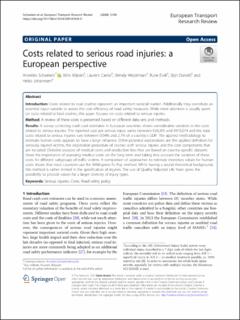| dc.contributor.author | Schoeters, Annelies | |
| dc.contributor.author | Wijnen, Wim | |
| dc.contributor.author | Carnis, Laurent | |
| dc.contributor.author | Weijermars, Wendy | |
| dc.contributor.author | Elvik, Rune | |
| dc.contributor.author | Daniels, Stijn | |
| dc.contributor.author | Johannsen, Heiko | |
| dc.coverage.spatial | Europe | en_US |
| dc.date.accessioned | 2021-07-28T11:02:45Z | |
| dc.date.available | 2021-07-28T11:02:45Z | |
| dc.date.created | 2020-11-11T09:14:49Z | |
| dc.date.issued | 2020-10-29 | |
| dc.identifier.citation | European Transport Research Review. 2020, 12, 1-12. | en_US |
| dc.identifier.issn | 1867-0717 | |
| dc.identifier.uri | https://hdl.handle.net/11250/2765519 | |
| dc.description.abstract | Introduction: Costs related to road crashes represent an important societal burden. Additionally they constitute an essential input variable to assess the cost efficiency of road safety measures. While most attention is usually spent on costs related to fatal crashes, this paper focuses on costs related to serious injuries. Method: A review of these costs is presented based on different data sets and methods. Results: A survey collecting crash cost estimates in European countries shows considerable variation in the costs related to serious injuries. The reported cost per serious injury varies between €28,205 and €975,074 and the total costs related to serious injuries vary between 0.04% and 2.7% of a country’s GDP. The applied methodology to estimate human costs appears to have a large influence. Other potential explanations are the applied definition for seriously injured victims, the registration procedure of crashes with serious injuries and the cost components that are included. Detailed analyses of medical costs and production loss that are based on country-specific datasets show the importance of assessing medical costs on the long term and taking into account the variation of these costs for different subgroups of traffic victims. A comparison of approaches to estimate monetary values for human costs shows that most countries use the Willingness To Pay method. While having a sound theoretical background, this method is rather limited in the specification of injuries. The use of Quality Adjusted Life Years gives the possibility to provide values for a larger diversity of injury types. | en_US |
| dc.language.iso | eng | en_US |
| dc.publisher | SpringerOpen | en_US |
| dc.rights | Navngivelse 4.0 Internasjonal | * |
| dc.rights | Navngivelse 4.0 Internasjonal | * |
| dc.rights.uri | http://creativecommons.org/licenses/by/4.0/deed.no | * |
| dc.title | Costs related to serious road injuries: a European perspective | en_US |
| dc.type | Peer reviewed | en_US |
| dc.type | Journal article | en_US |
| dc.rights.holder | © The Author(s). 2020 | en_US |
| dc.source.articlenumber | 58 | en_US |
| dc.description.version | publishedVersion | en_US |
| cristin.ispublished | true | |
| cristin.fulltext | postprint | |
| cristin.qualitycode | 1 | |
| dc.identifier.doi | 10.1186/s12544-020-00448-0 | |
| dc.identifier.cristin | 1846782 | |
| dc.source.journal | European Transport Research Review | en_US |
| dc.source.volume | 12 | en_US |
| dc.source.pagenumber | 1-12 | en_US |
| dc.relation.project | EC/H2020/633485 | en_US |

